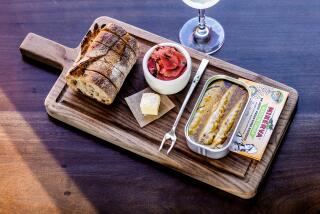Fish Wrapper but Not Fish Cooker
- Share via
Question: Is it harmful to wrap a trout in wet newspapers and bake it in a 500 degree oven? This was suggested on a recent television program.
Answer: We believe there’s a strong possibility this cooking technique could be harmful. The chemicals in recycled paper and ink used to print newspapers are not intended for human consumption. Since these toxic substances could be transferred to the fish during cooking, we recommend against using this cooking method.
Q: I have a wonderful tart recipe that calls for pastry flour. I’ve been cheating and using all-purpose flour, but can you tell me where to find pastry flour?
A: Pastry flour is used chiefly by commercial bakers and is not readily available to consumers. You might try using cake flour, although it is even more finely milled and the protein level may not be exactly equal.
Q: I have two favorite recipes that use uncooked eggs--tapioca pudding where the egg whites are beaten and folded in and key lime pie which uses raw egg yolks. Are these safe to eat? I have read several articles lately about the safety of eating eggs that are not properly cooked. Salmonella poisoning is of great concern to me.
A: California and federal health officials recommend that consumers avoid preparing recipes that feature uncooked eggs as part of the final presentation. For the past several years, numerous cases of salmonellosis have been linked to raw or undercooked eggs in the Northeastern United States. A similar incident occurred recently in California, said California and federal health officials. Unfortunately, eggs which look perfectly fine--clean, no cracks, no odor--can still be contaminated from within. Proceed with extreme caution if using raw eggs in recipes and carefully follow all proper food handling and storage procedures.
Q: I’m interested in how to boil an egg. My yolks are always dark and sometimes it’s impossible to remove the shell.
A: With Easter coming in a few weeks, many people are getting ready to color eggs. Now is a good time to refresh everyone’s memory. According to the American Egg Board, hard cook eggs by placing them in a single layer in a saucepan with enough cold tap water to measure at least one inch over the tops of the eggs. Cover and bring rapidly just to boiling. Turn off the heat and, if necessary, remove the pan from the burner to prevent further boiling.
Let the eggs stand in the hot water 15 minutes for large eggs. Increase or decrease the time by approximately 3 minutes for each size larger or smaller. Cool immediately and thoroughly in cold water so shells are easier to remove and to reduce the likelihood of having dark rings around the yolks.
To remove the shells, crack the eggs by tapping them gently all over. Roll the eggs between hands to loosen the shell, then peel, beginning at the large end. Holding the eggs under running cold water or dipping in a bowl of water will also help ease off the shells.
The key is to not boil the eggs, but bring them just to boiling. Shells that are difficult or impossible to remove are a sign of very fresh eggs, so purchase eggs a few days before they are to be hard-cooked.
Address questions on food preparation to You Asked About . . ., Food Section, The Times, Times Mirror Square, Los Angeles 90053. Personal replies cannot be given.

